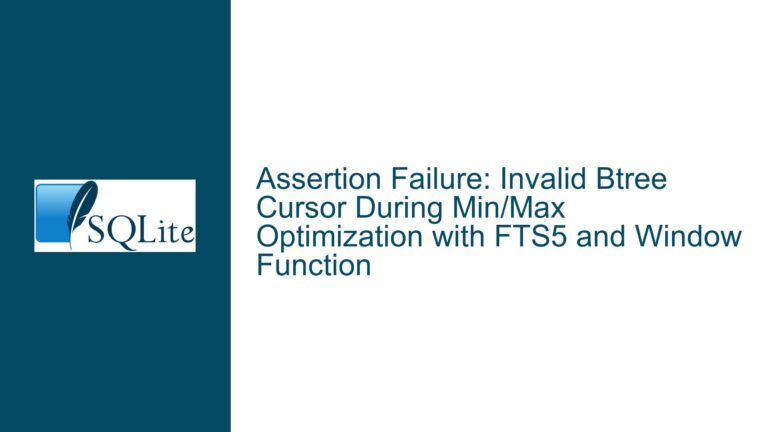Retaining Collation in SQLite After Using substr() Function
Understanding Collation Loss in SQLite When Using substr()
When working with SQLite, one of the most common tasks is manipulating strings using built-in functions like substr(). However, a subtle yet significant issue arises when applying such functions to columns with specific collations, such as NOCASE. The collation, which dictates how string comparisons are performed, is lost when the substr() function is applied. This behavior can lead to unexpected results in queries, especially when case-insensitive comparisons are required.
The core of the issue lies in how SQLite handles collations and affinities. Collations are attributes of columns, not expressions. When you apply a function like substr() to a column, the result is an expression, not a column. Consequently, the collation attribute is not automatically inherited by the result of the expression. This behavior is by design, as SQLite does not assume that the result of an expression should inherit the collation of its input column. This design choice allows for greater flexibility but can lead to confusion when the collation is essential for the query’s logic.
Why Collation is Lost in Expressions and How to Address It
The loss of collation when using functions like substr() is a direct consequence of SQLite’s handling of expressions. In SQLite, collations are properties of columns, not expressions. When you apply a function to a column, the result is an expression, and expressions do not inherently carry collation attributes. This behavior is consistent across SQLite’s design, where expressions are treated as independent entities without any implicit inheritance of column attributes.
To retain the collation after applying substr(), you must explicitly attach the collation to the result of the expression. This can be done using the COLLATE keyword, which allows you to specify the collation for the result of an expression. By doing so, you ensure that the collation is preserved, and the expression behaves as expected in subsequent comparisons.
Step-by-Step Solutions to Preserve Collation in SQLite Queries
To address the issue of collation loss when using substr(), you can follow these detailed steps to ensure that the collation is preserved:
Explicitly Attach Collation to the Expression: When creating a view or performing a query that involves the
substr()function, explicitly attach the desired collation to the result of the expression. For example, if you have a columnswithNOCASEcollation and you want to create a view that appliessubstr()to this column, you can do so as follows:CREATE VIEW b AS SELECT substr(s, 1, 3) COLLATE NOCASE AS s FROM t;This ensures that the result of the
substr()function retains theNOCASEcollation.Apply Collation in the WHERE Clause: If you are performing a query that involves a comparison with the result of
substr(), you can attach the collation directly in theWHEREclause. There are two ways to do this:- Attach the collation to the equality operator:
SELECT s FROM t WHERE substr(s, 1, 3) = 'aaa' COLLATE NOCASE; - Attach the collation to the result of the
substr()function:SELECT s FROM t WHERE substr(s, 1, 3) COLLATE NOCASE = 'aaa';
Both approaches ensure that the comparison is performed using the
NOCASEcollation.- Attach the collation to the equality operator:
Verify the Results: After applying the collation to the expression, verify that the query returns the expected results. For example, if you have a table
twith the following data:CREATE TABLE t(s TEXT COLLATE NOCASE); INSERT INTO t VALUES('AAA'),('aaa');And you create the view
bas shown above, the following query should return both rows:SELECT s FROM b WHERE s = 'aaa';The result should be:
+-----+ | s | +-----+ | AAA | | aaa | +-----+Considerations for Complex Queries: In more complex queries involving multiple expressions and collations, ensure that each expression that requires a specific collation has it explicitly attached. This is particularly important when joining tables or performing nested queries, where the collation of intermediate results can affect the final outcome.
Performance Implications: While attaching collations to expressions ensures correct behavior, it is also important to consider the performance implications. Collations can affect how indexes are used, and attaching collations to expressions may prevent SQLite from using indexes efficiently. Therefore, it is advisable to test and optimize queries that involve collations to ensure they perform well, especially with large datasets.
Alternative Approaches: In some cases, it may be more efficient to store precomputed values with the desired collation in the database, rather than applying collations dynamically in queries. For example, you could create a new column that stores the result of
substr(s, 1, 3)with theNOCASEcollation, and use this column in your queries. This approach can improve query performance by allowing SQLite to use indexes more effectively.Testing and Validation: Always test your queries thoroughly to ensure that the collation is applied correctly and that the results are as expected. This is especially important when dealing with case-insensitive comparisons, as subtle differences in collation handling can lead to unexpected results.
By following these steps, you can ensure that the collation is preserved when using the substr() function in SQLite, and that your queries return the expected results. This approach not only addresses the immediate issue but also helps you understand how SQLite handles collations and expressions, enabling you to write more robust and efficient queries in the future.
Conclusion
The issue of collation loss when using the substr() function in SQLite is a common pitfall that can lead to unexpected query results. By understanding how SQLite handles collations and expressions, and by explicitly attaching collations to expressions where necessary, you can ensure that your queries behave as expected. This detailed guide provides a comprehensive approach to addressing this issue, from understanding the underlying problem to implementing practical solutions. By following these steps, you can avoid common mistakes and write more effective SQLite queries that handle collations correctly.






